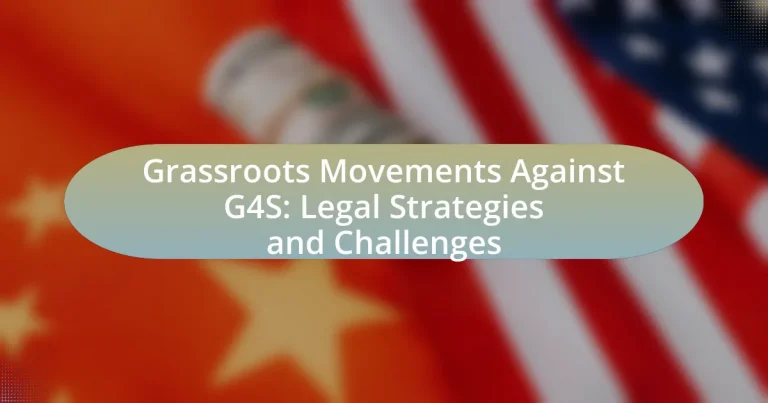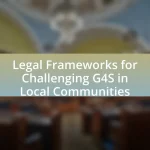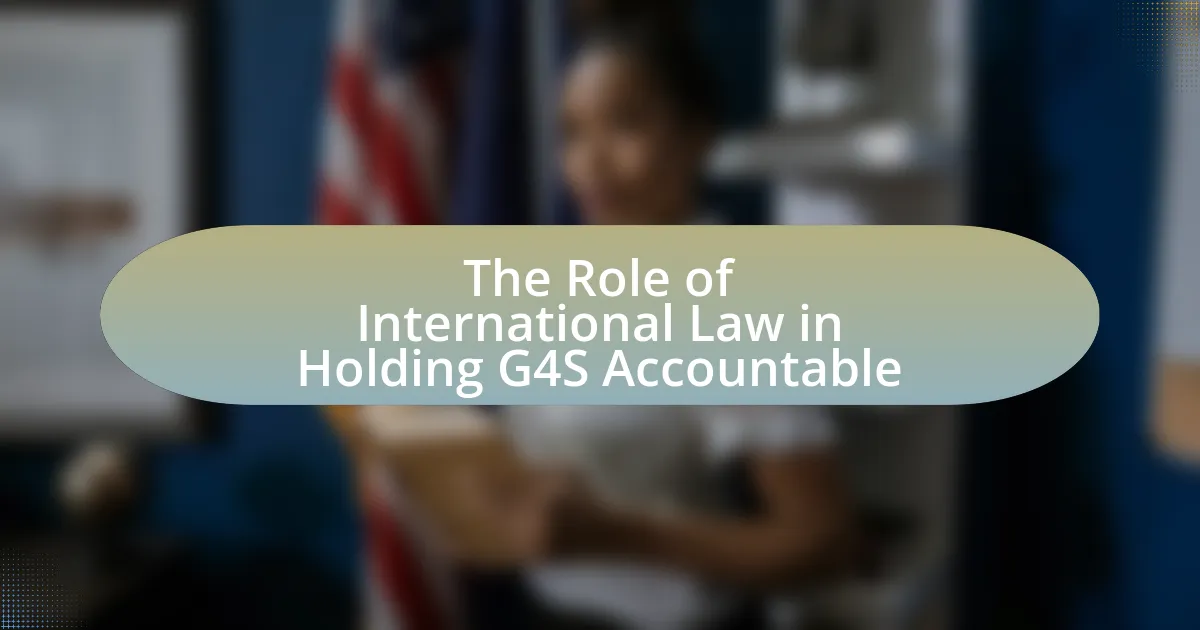Grassroots movements against G4S are community-driven initiatives aimed at challenging the multinational security company’s controversial practices, particularly in immigration detention and conflict zones. These movements mobilize local populations, utilize social media, and engage in protests to advocate for human rights and accountability. Key stakeholders include activists, community organizations, legal advocates, and affected individuals, all working towards goals such as promoting ethical standards and influencing public policy. The article explores the emergence of these movements, the social issues driving them, the legal strategies employed, and the challenges faced, including financial constraints and legal obstacles. It highlights the importance of collaboration between activists and legal experts, as well as the impact of successful legal outcomes on public perception and movement sustainability.
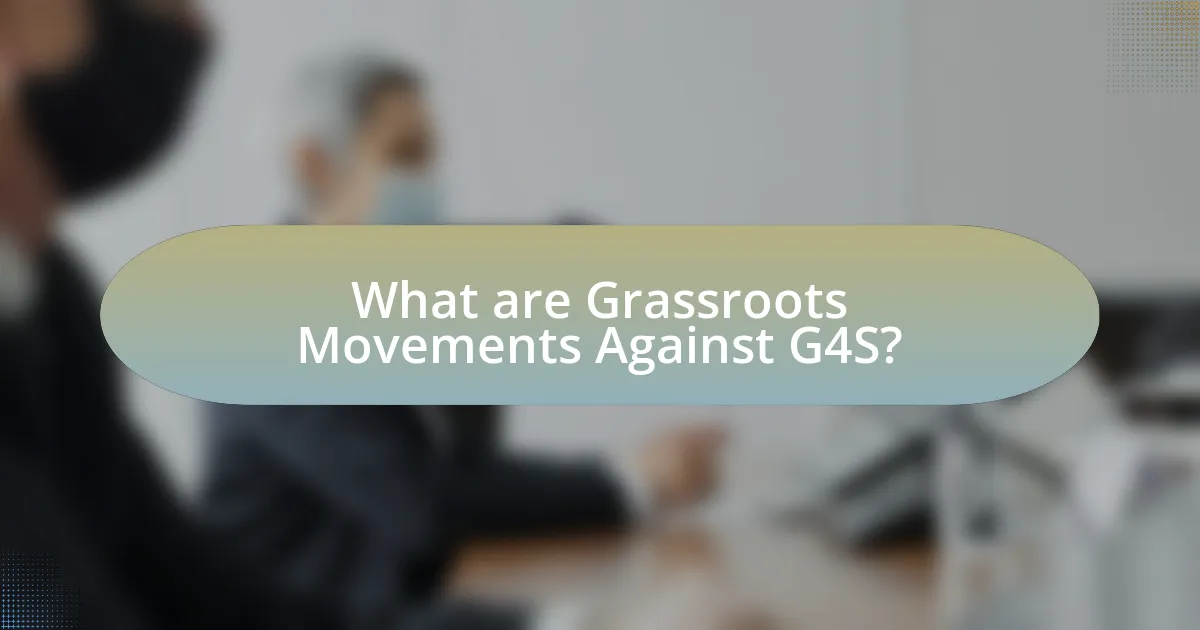
What are Grassroots Movements Against G4S?
Grassroots movements against G4S are organized efforts by communities and activists aimed at challenging the practices and policies of the multinational security company G4S, particularly regarding its involvement in controversial activities such as immigration detention and security services in conflict zones. These movements often mobilize local populations, leverage social media, and engage in protests to raise awareness about G4S’s operations, advocating for human rights and accountability. For instance, campaigns like “Boycott G4S” have emerged, highlighting the company’s role in the Israeli-Palestinian conflict and calling for divestment from institutions that support G4S.
How do grassroots movements emerge in response to G4S?
Grassroots movements emerge in response to G4S primarily due to community mobilization against perceived injustices and human rights violations associated with the company’s operations. These movements often arise when local communities experience negative impacts from G4S’s security practices, such as excessive force or discrimination, prompting collective action to address grievances. For instance, in various regions, activists have organized protests and campaigns to raise awareness about G4S’s involvement in controversial activities, such as operating in conflict zones or managing detention facilities criticized for inhumane conditions. This mobilization is often fueled by social media, which facilitates communication and coordination among activists, allowing them to share information and strategies effectively.
What social issues drive the formation of these movements?
Social issues driving the formation of grassroots movements against G4S include systemic injustice, human rights violations, and economic inequality. These movements often emerge in response to G4S’s involvement in controversial practices, such as the privatization of public services, which can lead to reduced accountability and transparency. For instance, reports have highlighted G4S’s role in the detention of migrants and the management of prisons, raising concerns about the treatment of vulnerable populations. Additionally, economic disparities are exacerbated by the company’s practices, as communities affected by G4S operations often face job insecurity and lack access to essential services. These factors collectively motivate individuals and groups to mobilize for change, advocating for accountability and reform in the face of perceived injustices.
Who are the key stakeholders involved in these movements?
The key stakeholders involved in grassroots movements against G4S include activists, community organizations, legal advocates, affected individuals, and policymakers. Activists mobilize public support and awareness, while community organizations provide resources and networks for collective action. Legal advocates work to navigate the judicial system and challenge G4S’s practices through litigation. Affected individuals, such as those directly impacted by G4S’s operations, share their experiences to highlight injustices. Policymakers may influence regulations and policies that affect G4S’s operations, thereby shaping the context in which these movements operate.
What are the goals of grassroots movements against G4S?
The goals of grassroots movements against G4S include advocating for human rights, promoting accountability for alleged abuses, and pushing for the divestment from G4S by institutions. These movements aim to raise awareness about G4S’s involvement in controversial practices, such as operating detention centers and providing security services in conflict zones. For instance, campaigns have highlighted G4S’s role in the Israeli-Palestinian conflict, urging organizations to sever ties with the company due to its involvement in activities perceived as violating international law. Additionally, grassroots efforts seek to mobilize public support and influence policy changes that align with ethical standards regarding security and human rights.
How do these movements aim to influence public policy?
Grassroots movements against G4S aim to influence public policy by mobilizing community support, raising awareness about human rights violations, and advocating for legislative changes. These movements utilize strategies such as organizing protests, engaging in public campaigns, and leveraging social media to disseminate information about G4S’s practices. For instance, campaigns have highlighted specific incidents of abuse, prompting local governments to reconsider contracts with G4S and implement stricter oversight measures. Additionally, these movements often collaborate with legal experts to challenge policies that enable G4S’s operations, thereby directly impacting public policy decisions at various governmental levels.
What changes do they seek in G4S’s practices?
Grassroots movements seek significant changes in G4S’s practices, particularly in areas related to human rights, labor conditions, and accountability. These movements advocate for improved treatment of workers, transparency in operations, and adherence to ethical standards, especially in regions where G4S operates under controversial circumstances. For instance, reports have highlighted instances of human rights abuses linked to G4S’s security operations in conflict zones, prompting calls for the company to implement stricter oversight and ethical guidelines.
Why are legal strategies important for grassroots movements against G4S?
Legal strategies are crucial for grassroots movements against G4S because they provide a framework for challenging the company’s practices through established legal channels. These strategies enable activists to hold G4S accountable for alleged human rights violations and unethical practices, such as those reported in various contexts, including immigration detention and security operations. For instance, legal actions can lead to court rulings that impose restrictions on G4S’s operations or require compliance with human rights standards, thereby amplifying the movement’s impact. Additionally, successful legal challenges can garner public attention and support, further mobilizing community engagement and advocacy efforts against G4S.
What legal frameworks do these movements operate within?
Grassroots movements against G4S operate within various legal frameworks, including international human rights law, national labor laws, and local regulations governing protests and demonstrations. These frameworks provide the legal basis for advocating against the practices of G4S, which has faced criticism for its involvement in controversial activities such as immigration detention and security operations in conflict zones. For instance, international human rights treaties, such as the International Covenant on Civil and Political Rights, establish the right to peaceful assembly, which grassroots movements leverage to organize protests. Additionally, national labor laws may protect workers’ rights to organize and strike, allowing movements to challenge G4S’s labor practices. Local regulations often dictate the parameters for public demonstrations, influencing how movements can legally express dissent.
How can legal strategies enhance the effectiveness of grassroots movements?
Legal strategies can enhance the effectiveness of grassroots movements by providing a framework for advocacy that legitimizes their claims and actions. By utilizing legal avenues such as litigation, policy advocacy, and regulatory engagement, grassroots movements can challenge injustices and hold powerful entities accountable. For instance, successful lawsuits against corporations for human rights violations can lead to significant changes in corporate practices and policies, as seen in cases like the Kiobel v. Royal Dutch Petroleum, where legal action brought attention to environmental and human rights abuses. Furthermore, legal strategies can mobilize public support and increase visibility, as legal battles often attract media coverage, thereby amplifying the movement’s message and objectives.
What challenges do grassroots movements face in their legal strategies?
Grassroots movements face significant challenges in their legal strategies, primarily due to limited financial resources and access to legal expertise. These movements often operate on tight budgets, which restricts their ability to hire experienced legal counsel or fund extensive litigation. For instance, a study by the National Lawyers Guild highlights that many grassroots organizations struggle to navigate complex legal systems, resulting in inadequate representation in court. Additionally, grassroots movements frequently encounter legal barriers such as restrictive laws and regulations that can hinder their ability to mobilize and advocate effectively. These challenges are compounded by the potential for legal retaliation from powerful entities, which can intimidate activists and deter participation.
What are the common legal obstacles encountered?
Common legal obstacles encountered by grassroots movements against G4S include regulatory compliance issues, challenges in obtaining permits for protests, and potential legal actions from G4S aimed at suppressing dissent. Regulatory compliance issues arise when movements must navigate complex laws governing public assembly and protest, which can vary significantly by jurisdiction. Additionally, obtaining permits for demonstrations often involves lengthy bureaucratic processes that can delay or hinder activism. Legal actions from G4S, such as lawsuits for defamation or trespassing, can intimidate activists and deter participation. These obstacles collectively create a challenging environment for grassroots movements seeking to advocate for change.
How do financial constraints impact legal efforts?
Financial constraints significantly hinder legal efforts by limiting access to necessary resources, such as legal representation and expert witnesses. For grassroots movements, insufficient funding restricts their ability to file lawsuits, conduct thorough research, and sustain prolonged legal battles against well-funded entities like G4S. Studies indicate that organizations with limited financial resources often struggle to compete in legal contexts, resulting in lower success rates in litigation. For instance, a report by the National Center for State Courts highlights that inadequate funding can lead to fewer cases being pursued, ultimately affecting the overall effectiveness of legal strategies employed by grassroots movements.
How do grassroots movements collaborate with legal experts?
Grassroots movements collaborate with legal experts by seeking their guidance on legal frameworks, strategies, and advocacy efforts. These collaborations often involve legal experts providing pro bono services, conducting workshops, and assisting in the drafting of legal documents to support the movement’s objectives. For instance, during campaigns against corporations like G4S, legal experts help grassroots organizations navigate complex legal landscapes, ensuring compliance with laws while maximizing their impact. This partnership enhances the movement’s credibility and effectiveness, as evidenced by successful legal challenges that have emerged from such collaborations, demonstrating the importance of legal expertise in grassroots activism.
What role do lawyers play in supporting these movements?
Lawyers play a crucial role in supporting grassroots movements against G4S by providing legal expertise, advocacy, and representation. They assist in navigating complex legal frameworks, ensuring that the rights of activists and community members are protected during protests and legal challenges. For instance, lawyers can help draft legal documents, represent individuals in court, and advise on compliance with local laws, which is essential for the sustainability of these movements. Additionally, legal professionals often engage in strategic litigation to challenge unlawful practices by G4S, thereby reinforcing the movement’s objectives and increasing public awareness of the issues at stake.
How can legal education empower grassroots activists?
Legal education can empower grassroots activists by equipping them with essential knowledge of laws, rights, and legal processes that can be leveraged in advocacy efforts. This education enables activists to understand legal frameworks, navigate the judicial system, and effectively challenge injustices, thereby enhancing their ability to mobilize communities and advocate for change. For instance, studies show that grassroots organizations with trained legal personnel are more successful in litigation and policy advocacy, as they can articulate legal arguments and strategies that resonate with both the public and decision-makers.
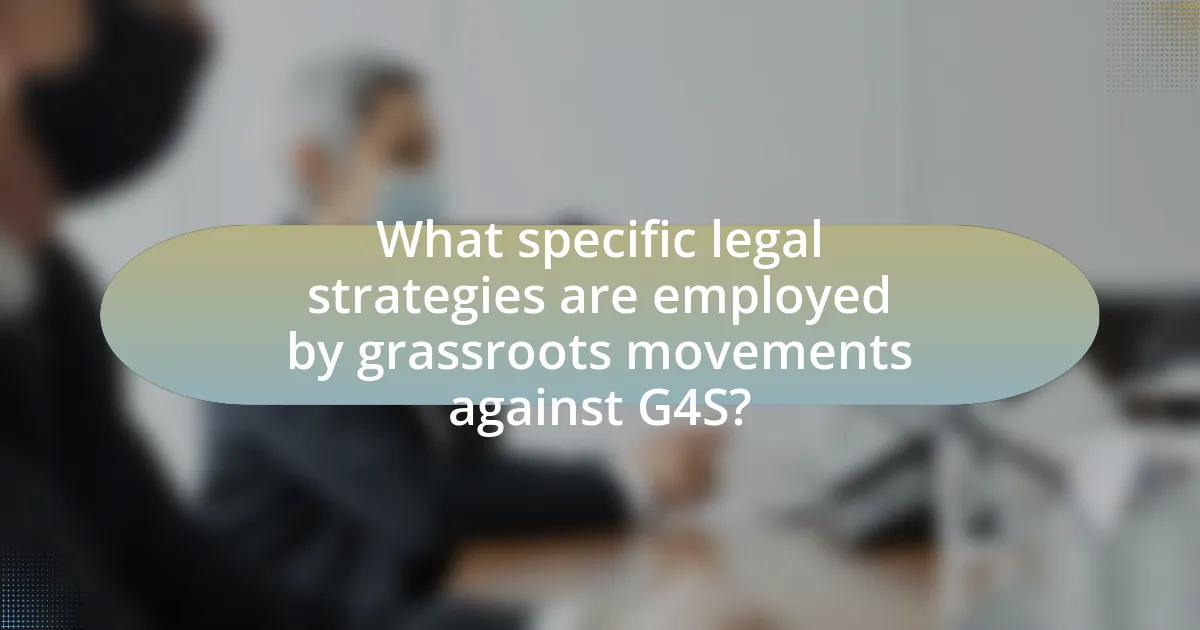
What specific legal strategies are employed by grassroots movements against G4S?
Grassroots movements employ various legal strategies against G4S, including litigation, public campaigns for policy changes, and advocacy for regulatory reforms. These movements often file lawsuits to challenge G4S’s contracts and practices, citing violations of human rights and labor laws. For instance, organizations like the International Network of People Who Use Drugs have initiated legal actions to hold G4S accountable for its role in immigration detention centers, arguing that the company engages in unlawful practices. Additionally, grassroots movements mobilize public opinion through campaigns that pressure local governments to reconsider or terminate contracts with G4S, highlighting the company’s controversial practices. These strategies are supported by legal frameworks that allow for public interest litigation and community advocacy, reinforcing the movements’ efforts to challenge G4S’s operations effectively.
How do grassroots movements utilize litigation as a strategy?
Grassroots movements utilize litigation as a strategy to challenge systemic injustices and hold powerful entities accountable. By filing lawsuits, these movements aim to create legal precedents that can lead to broader social change, as seen in cases like the 2018 lawsuit against the U.S. government by the ACLU, which sought to end family separations at the border. This legal approach not only raises public awareness but also mobilizes community support and resources, enhancing the movement’s visibility and impact. Furthermore, successful litigation can result in policy changes or financial compensation, reinforcing the movement’s objectives and empowering affected communities.
What types of cases are commonly pursued against G4S?
Common cases pursued against G4S typically involve allegations of human rights violations, labor disputes, and negligence in security services. For instance, G4S has faced lawsuits related to the treatment of detainees in immigration facilities, where claims of abuse and inadequate care have been reported. Additionally, labor-related cases often arise from employee grievances regarding working conditions, wage disputes, and wrongful termination. These legal actions reflect broader concerns about the company’s operational practices and accountability in various sectors, including security and detention services.
What outcomes have been achieved through litigation?
Litigation against G4S has resulted in significant outcomes, including financial settlements, policy changes, and increased accountability for human rights violations. For instance, various grassroots movements have successfully secured compensation for victims of G4S’s actions, highlighting the company’s liability in cases of abuse and negligence. Additionally, litigation has prompted G4S to revise its operational policies, particularly in areas related to the treatment of detainees and the use of force. These legal actions have also raised public awareness and pressured G4S to improve its practices, demonstrating the effectiveness of legal strategies in advocating for social justice and human rights.
What alternative legal strategies do grassroots movements explore?
Grassroots movements explore alternative legal strategies such as community organizing, public interest litigation, and strategic use of local ordinances. Community organizing empowers individuals to collectively advocate for their rights, often leading to increased public awareness and support. Public interest litigation allows grassroots groups to challenge unjust laws or practices in court, leveraging legal frameworks to promote social change. Additionally, strategic use of local ordinances enables these movements to enact change at the municipal level, bypassing more complex state or federal legal systems. These strategies have been employed effectively in various contexts, demonstrating their potential to influence policy and legal outcomes.
How do advocacy campaigns complement legal actions?
Advocacy campaigns complement legal actions by raising public awareness and mobilizing community support, which can influence legal outcomes. For instance, advocacy efforts can generate media attention that pressures lawmakers and judicial systems to consider the broader social implications of legal cases. Additionally, grassroots movements often provide essential resources, such as funding and volunteer support, that enhance the capacity of legal teams to pursue cases effectively. Research indicates that cases with strong public backing tend to receive more favorable judicial consideration, as seen in various civil rights movements where advocacy played a crucial role in shaping legal precedents.
What role does public awareness play in legal strategies?
Public awareness significantly enhances legal strategies by mobilizing community support and influencing public opinion. When grassroots movements raise awareness about legal issues, they can generate public pressure that compels legal entities to act or reconsider their positions. For instance, campaigns that highlight injustices or unethical practices can lead to increased media coverage, which in turn can attract the attention of policymakers and legal advocates. This dynamic was evident in various cases where public outcry led to legal reforms or changes in corporate behavior, demonstrating that informed citizens can effectively challenge powerful entities like G4S.
What are the implications of legal strategies on grassroots movements’ effectiveness?
Legal strategies significantly enhance the effectiveness of grassroots movements by providing a framework for challenging injustices and mobilizing public support. These strategies enable movements to leverage legal mechanisms, such as litigation and advocacy, to hold powerful entities accountable, as seen in cases where grassroots organizations successfully sued corporations for labor violations. For instance, the legal actions taken by grassroots groups against G4S for alleged human rights abuses have not only raised awareness but also pressured the company to change its practices. Furthermore, legal strategies can help secure funding and resources, as successful legal outcomes often attract donations and grants, thereby strengthening the movement’s capacity to operate and expand its reach.
How do successful legal outcomes influence public perception of G4S?
Successful legal outcomes positively influence public perception of G4S by enhancing its credibility and trustworthiness. When G4S prevails in legal disputes, it signals to the public that the company operates within legal and ethical boundaries, potentially mitigating negative narratives surrounding its practices. For instance, a favorable ruling in a high-profile case can lead to increased confidence among stakeholders, as it demonstrates the company’s compliance with regulations and its commitment to accountability. This shift in perception can be crucial for G4S, especially in the context of grassroots movements that often challenge its operations, as positive legal outcomes can counteract claims of misconduct and reinforce the company’s legitimacy in the eyes of the public.
What long-term impacts can legal victories have on grassroots movements?
Legal victories can significantly enhance the sustainability and effectiveness of grassroots movements. These victories often provide a legal framework that legitimizes the movement’s goals, enabling increased public support and engagement. For instance, successful litigation can lead to policy changes that align with the movement’s objectives, as seen in various civil rights cases where court rulings have resulted in legislative reforms. Additionally, legal victories can attract funding and resources, as donors are more likely to support movements with proven success in achieving tangible outcomes. Historical examples include the landmark Brown v. Board of Education case, which not only dismantled segregation but also galvanized civil rights activism across the United States, demonstrating how legal success can create a ripple effect that strengthens grassroots efforts over time.
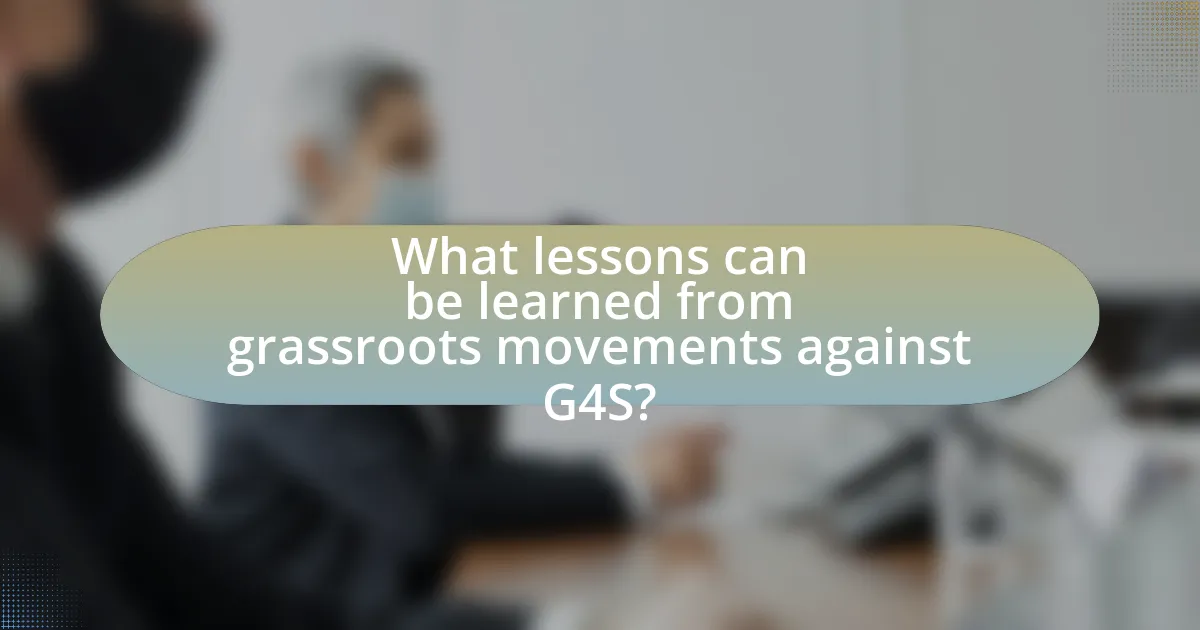
What lessons can be learned from grassroots movements against G4S?
Grassroots movements against G4S demonstrate the effectiveness of community organizing and coalition-building in challenging corporate practices. These movements have shown that mobilizing local communities can lead to significant pressure on corporations to change their policies, as evidenced by successful campaigns that resulted in contract cancellations and public accountability measures. For instance, the boycott campaigns led by organizations like Boycott G4S have highlighted human rights violations associated with G4S operations, leading to a decline in contracts with institutions such as universities and local governments. This illustrates that sustained activism can influence public perception and corporate behavior, ultimately leading to policy changes that align with community values and human rights standards.
What best practices can be identified from successful movements?
Successful movements often employ clear communication, strategic coalition-building, and grassroots mobilization as best practices. Clear communication ensures that the movement’s goals and messages resonate with a broad audience, as seen in the Civil Rights Movement, where effective messaging galvanized public support. Strategic coalition-building allows diverse groups to unite for a common cause, exemplified by the Women’s March, which brought together various organizations to amplify their impact. Grassroots mobilization engages community members directly, fostering local ownership and commitment, as demonstrated by the Fight for $15 campaign, which effectively organized fast-food workers to advocate for higher wages. These practices contribute to the overall effectiveness and sustainability of movements.
How can grassroots movements effectively mobilize community support?
Grassroots movements can effectively mobilize community support by fostering strong local connections and utilizing targeted communication strategies. Engaging community members through face-to-face interactions, social media campaigns, and local events builds trust and encourages participation. For instance, the Fight for $15 movement successfully mobilized support by organizing rallies and leveraging social media to highlight the struggles of low-wage workers, resulting in significant policy changes in various cities. This approach demonstrates that grassroots movements can create a sense of urgency and collective identity, which is crucial for mobilizing community support.
What strategies enhance collaboration among activists and legal experts?
Effective strategies that enhance collaboration among activists and legal experts include establishing clear communication channels, fostering mutual respect, and creating interdisciplinary teams. Clear communication ensures that both parties understand each other’s goals and constraints, which is essential for coordinated efforts. Mutual respect allows activists to appreciate the legal framework within which they operate, while legal experts gain insights into the grassroots movements’ objectives and urgency. Interdisciplinary teams, which combine the strengths of both activists and legal professionals, can lead to innovative legal strategies that address specific challenges faced by grassroots movements, such as those opposing G4S. For instance, successful collaborations have been documented in cases where legal experts provided pro bono services to activists, resulting in effective legal challenges against corporate practices.
What common pitfalls should grassroots movements avoid?
Grassroots movements should avoid the pitfalls of lack of clear goals, insufficient organization, and failure to engage with the community. A lack of clear goals can lead to confusion and diluted efforts, making it difficult to mobilize support or measure success. Insufficient organization can result in ineffective communication and coordination, hindering the movement’s ability to respond to challenges. Additionally, failing to engage with the community can alienate potential supporters and diminish the movement’s impact. Historical examples, such as the Occupy Wall Street movement, illustrate how these pitfalls can undermine grassroots efforts, as the lack of a unified message and organizational structure contributed to its decline.
How can movements ensure sustainable engagement from supporters?
Movements can ensure sustainable engagement from supporters by fostering a strong sense of community and shared purpose. This can be achieved through regular communication, transparent decision-making, and providing opportunities for supporters to actively participate in initiatives. Research indicates that movements that engage supporters through personalized outreach and inclusive practices see higher retention rates; for example, the 2018 study by the Stanford Social Innovation Review found that organizations with strong community ties had a 30% increase in volunteer engagement over two years. By creating a collaborative environment and recognizing the contributions of supporters, movements can maintain long-term commitment and enthusiasm.
What strategies can prevent burnout among activists?
To prevent burnout among activists, implementing self-care practices, establishing supportive networks, and setting realistic goals are essential strategies. Self-care practices, such as regular breaks, mindfulness, and physical activity, help maintain mental and emotional well-being. Supportive networks provide emotional and practical assistance, fostering resilience through shared experiences. Setting realistic goals ensures that activists do not overwhelm themselves with unattainable expectations, which can lead to feelings of inadequacy and exhaustion. Research indicates that activists who engage in these strategies report higher levels of satisfaction and lower levels of stress, reinforcing their effectiveness in combating burnout.
What practical tips can grassroots movements apply in their legal strategies?
Grassroots movements can enhance their legal strategies by focusing on community engagement, building coalitions, and utilizing legal education. Engaging the community fosters support and mobilizes resources, while coalitions amplify voices and increase influence. Legal education empowers members with knowledge about their rights and legal processes, enabling informed participation. For instance, successful grassroots campaigns often include workshops that educate participants on relevant laws and legal rights, which can lead to more effective advocacy and resistance against entities like G4S.
How can movements effectively document their cases?
Movements can effectively document their cases by systematically collecting and organizing evidence, including testimonies, photographs, and legal documents. This method ensures that all relevant information is captured, which can be used to support claims and raise awareness. For instance, the use of digital platforms allows for the easy sharing and archiving of materials, making it accessible for future reference and advocacy. Additionally, employing data management tools can enhance the analysis of patterns and trends in cases, thereby strengthening the movement’s narrative and legal arguments.
What resources are available for grassroots movements seeking legal support?
Grassroots movements seeking legal support can access various resources, including legal aid organizations, pro bono legal services, and advocacy groups specializing in civil rights and social justice. Legal aid organizations, such as the Legal Services Corporation in the United States, provide free or low-cost legal assistance to individuals and groups facing legal challenges. Pro bono services offered by law firms and individual attorneys can also support grassroots movements by providing legal representation and advice without charge. Additionally, advocacy groups like the American Civil Liberties Union (ACLU) and the National Lawyers Guild offer resources, legal expertise, and support for grassroots initiatives, particularly those focused on civil rights and social justice issues. These resources are crucial for empowering grassroots movements to navigate legal challenges effectively.
